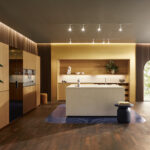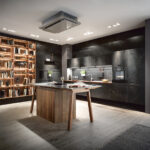As remote and hybrid working becomes commonplace, flexibility is now one of the most desirable qualities in a modern home. Advances in technology mean that we’re gradually doing more and more from the comfort of our own homes, whether working, socialising, exercising, or entertaining. Now more than ever, homeowners are searching for ways to get the most out of their living spaces.
One way of bringing a more versatile, dynamic feel to your home is through open-plan design. Features like an open-plan kitchen-living room can bring some much-needed fluidity into your spaces, which can benefit everyone from single-person houses to those with big families. And it doesn’t have to cost a fortune to execute. If this sounds like the ideal thing to refresh your home this year, we’ve put together the following guide to help you get started. Below, we’ll cover:
- What is open-plan living?
- The pros and cons of open-plan living
- How to design an open-plan living space
What is open-plan living?
Characterised by large, interconnected rooms that serve multiple functions, open-plan designs have become a popular feature in modern homes. They’re a great way to create a better sense of flow in a home, making the most out of properties that are slightly on the smaller side.
If you’re considering this style of home design, you may be envisioning an open-plan kitchen diner which integrates your dining space into the main kitchen area. This is one of the most popular open-plan living concepts, as its main components are a conveniently shaped kitchen and a dining table or breakfast island that fits in the space available. However, an open-plan approach can also be incorporated into other areas of the house. For instance, you may have a walk-in wardrobe or dressing room that adjoins the bedroom, or a separate, cosy reading nook just off the living room. Any way you can make your rooms flow together more seamlessly will help create the perfect open-plan home for you.
The pros and cons of open-plan living
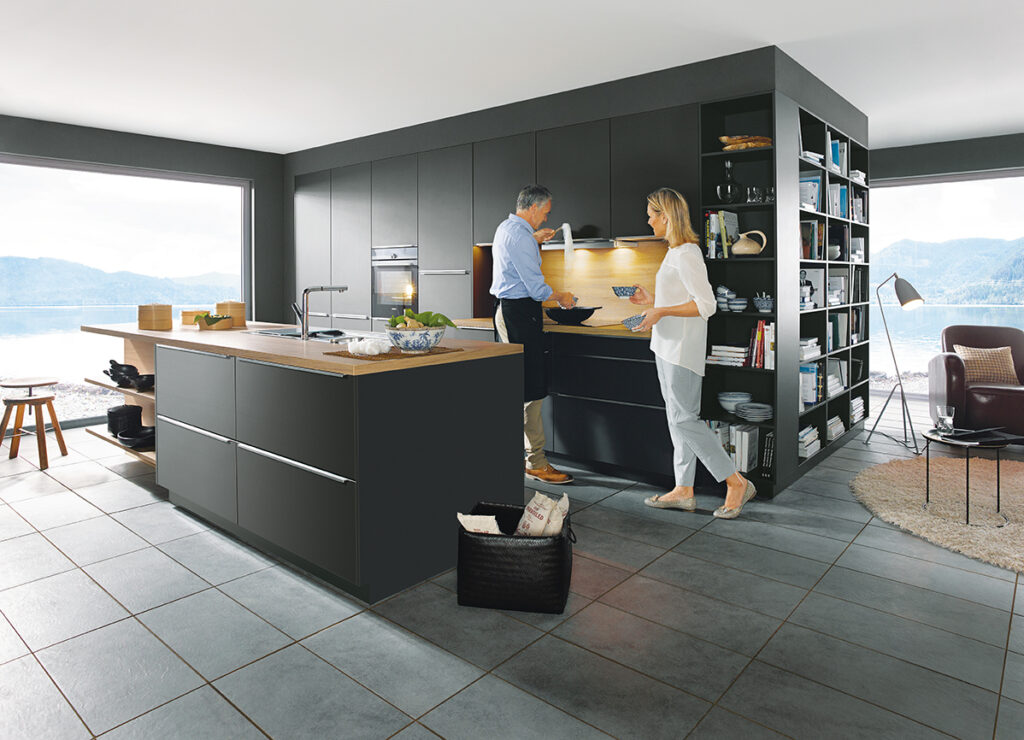
As with any home design, open-plan living has its benefits and drawbacks. So, before you implement any new features or modifications in your property, make sure you consider how it will suit your home dynamic. This will of course depend on whether you live alone, with a partner, or with a large family, so take the time to consider how this will work with your day-to-day home life.
Great for family life and entertaining
The main selling point of an open-plan design is the flexibility it provides, as it can be tailored to how you use your home. This means that while it is often a popular choice for aesthetic reasons, open-plan living spaces can also be the most functional — when they’re done right.
Firstly, open-plan kitchen diners are great for accommodating groups. Blending your kitchen and dining areas is an excellent way to bring the whole family together, whether you’re chatting over breakfast or catching up over an evening meal. This is because when your seating area is incorporated into your kitchen, whoever is cooking can still join the conversation without having to leave the stove. Not only this, but it can also make cooking a more collaborative experience, which is great if you’re trying to involve the kids more in household responsibilities.
This also makes open-plan living spaces great for dinner parties and entertaining. As the host, you can easily transfer drinks and meals straight from the kitchen to the dining table without having to carry them to another room. Kitchen islands can double as a drinks station or a place to lay out appetisers, and if you have folding doors, you can even open up your dining space to the garden in summer.
Maximises natural light

Put simply, with fewer walls you’ll get to experience more natural light in your home. This is one of the main reasons why open-plan design has become more popular in recent years, as more traditional home layouts with multiple small rooms can be seen as somewhat outdated.
Increased exposure to daylight not only makes us feel more alert and positive but also reduces the amount of energy we use to light our homes. Not only this, but properties with smaller footprints will feel bigger, brighter, and more inviting when you combine an open-plan layout with more natural light. Many people opt for large, even floor-length windows in their blended kitchen-living space to let in as much light as possible. It’s also wise to position furniture like your dining table and sofa towards these windows so that you, your family, and guests can make the most of that natural daylight.
Things to consider
Open-plan living spaces might be great for bringing the family together, but this can sometimes be one of its drawbacks! If you’re new to open-plan design, it may take you a little time to adjust to your main living spaces being interconnected. If this is something you’re concerned about, further down we’ve shared some top tips on how to create subtle zones throughout your kitchen-living space to help with this.
Another practical concern in open-plan kitchen diners is lingering cooking aromas. They may smell delicious at the time, but once your dinner party is over, you’ll want any unwanted scents to quickly disperse from your living and dining space. So proper ventilation is an important feature to remember when designing an open-plan home. If you have limited windows or don’t want to let any valuable heat out of your home, then extractor fans are an essential investment. If you’re concerned about these interfering with the look of your kitchen diner, our range of Wave extractor hoods seamlessly combines aesthetics with function. Wave has everything from statement pendants to wall-hung designs in steel, copper, and leather to give you a choice of practical pieces that look beautiful too. Or, for an even more subtle solution, invest in a kitchen island with a built-in extractor fan.
Finally, the last potential drawback of open-plan living spaces is the need to keep them tidy. When you integrate the main rooms in your home, you can no longer shut the door on a cluttered room and tackle it another day. It’s therefore crucial to include plenty of storage space in your kitchen and living areas — making the most of space with vertical storage solutions — so you can easily tidy away cooking equipment, books, or children’s toys.
How to design an open-plan living space
Once you’ve assessed whether this design style is right for you, you can start putting together a plan for your interiors. If you need a little inspiration, below you’ll find some of our favourite open-plan kitchen and living room ideas to help you get started.
Create subtle partitions and ‘zones’
If your new living space feels a little too open, you can always add in some features that allow you to close off certain spaces as and when you need them. If you’re renovating your home to create an open-plan design, then you may choose to leave a half-wall that provides some division without blocking out too much light. Sliding, bi-fold, or pocket doors (which slide away into a wall cavity) are also excellent for closing off certain areas. However, if you want something a little less imposing or permanent, you can always use things like rugs, large houseplants, or decorative screens to create a subtle partition that groups your living room furniture together.
You could also do this more subtly by ‘zoning’ different areas of the room. This involves giving each area its own unique style, depending on what you use it for. For example, you might choose to keep the kitchen bright, sleek, and minimalist. You could then differentiate the adjoining living room as a place for leisure by adding soft furnishings or permanent fixtures like a built-in bookshelf. You may even choose to give each area its own colour scheme to make a clearer distinction between living spaces.
However, remember that it’s important to maintain a sense of flow and connection in an open-plan home, so be careful not to have any stark, clashing designs between the different zones. A great way to keep this sense of cohesion is by decorating each zone with a different shade, but staying within the same complementary colour palette. This way your open-plan kitchen-living room still has a consistent aesthetic.
Prioritise function in an open-plan kitchen
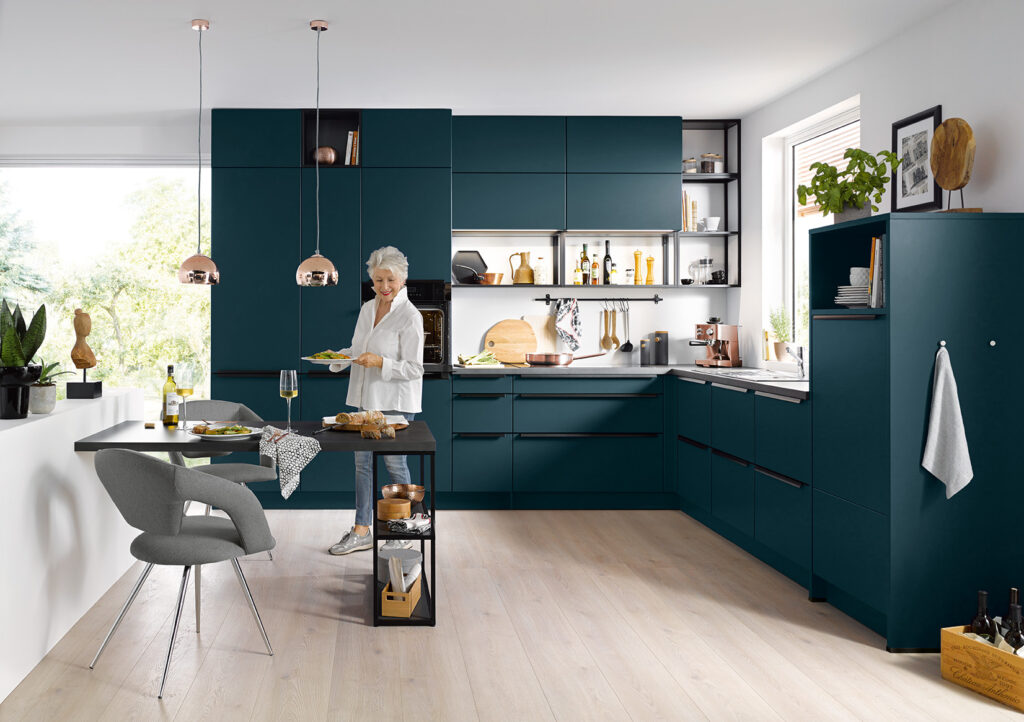
When creating an open-plan kitchen diner, flexibility and practicality should be your two main priorities. As well as finding creative ways to blend these two spaces into one, it’s important that you factor in enough room for kitchen appliances and storage solutions like pantry shelving and utility cabinets to comfortably use this space every day.
One key step in the practical design process is deciding on the shape of your kitchen. This will depend on the space you have available and should take into consideration things like the placement of windows and doors. Ultimately, this shape will determine how your open-plan space flows and functions, so don’t rush your decision and be sure to find the perfect fit for your home. Popular choices for open-plan kitchens include L-shaped, one-wall, island, and U-shaped kitchens, as these allow a dining space to be easily incorporated. To find out more about these design styles, check out our detailed guide to designing a kitchen.
When it comes to flexibility in the home, an open-plan kitchen diner is invaluable. For example, you can turn your island kitchen into a breakfast bar simply by clearing some counter space and adding a few stylish bar stools. You can also create your own breakfast nook by positioning a small set of tables and chairs (or even building a small, cushioned booth) in a free corner of your kitchen. This gives you a separate seating area away from your main dining table that’s perfect for quick morning meals.
Decorating an open-plan living space
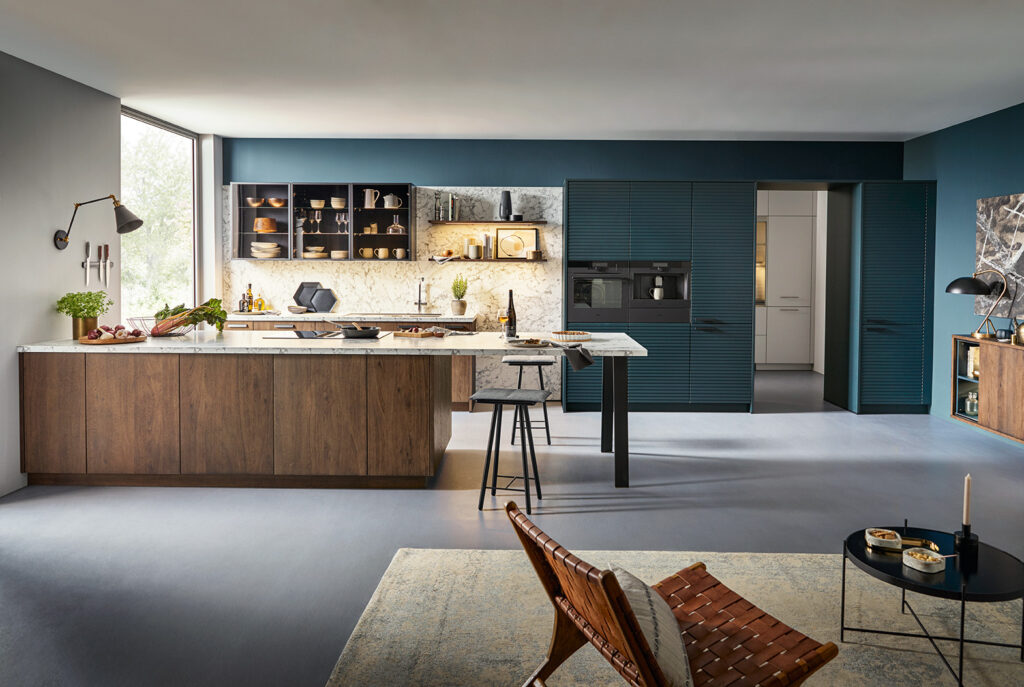
Once you’ve decided how to design your open-plan living space, you can start thinking about décor and other finishing touches. One of the most important aspects of your home design is the colour palette you choose, so decide on your colour scheme early on. Not only do colours help to zone your open-plan living space, but they can also have a huge impact on the size, light, and overall aesthetic of your home.
If your kitchen diner is compact, be sure to opt for light-coloured flooring and worktops. Lighter shades help to make everything feel bigger and brighter, even if you’re working with a smaller space. And you can still add pops of colour through feature walls, rugs and accessories. Kitchen cabinets with high gloss finishes can also help to reflect light and brighten up compact spaces with a limited amount of daylight. However, if you’re working with a large kitchen-living space with plenty of natural light, you can afford to further embrace darker tones. For example, a bold sea blue can make a stunning statement kitchen, as can units in a playful pink shade to add a little personality to your home.
In your adjoining living space, you may opt for a different style of flooring to differentiate between areas. If you don’t, then soft furnishings like rugs can help make this distinction while adding comfort and making your living area feel cosier. Add comfortable seating, warm lighting, and furniture like a coffee table or sideboard to bring it all together. Be sure to incorporate enough shelving and storage spaces in your living area, too, as it’s important to keep an open-plan home tidy and clutter-free.
We hope this guide has helped you get inspired about the possibilities of open-plan living. If you’re planning to redesign your home, here at InHouse we have a huge range of premium German kitchens to choose from, designed by Schüller and their statement brand next125. We also have a wide selection of Systemo worktops in everything from ceramic, solid wood, and steel to quartz stone, glass, and solid wood. Be sure to browse our range of Italian living room furniture from Colombini Casa, too, and you’ll have everything you need to create a beautiful, bespoke open-plan home.
For more expert advice and interior design inspiration, check out our blog or come and visit our impressive showroom based in Hexham.

